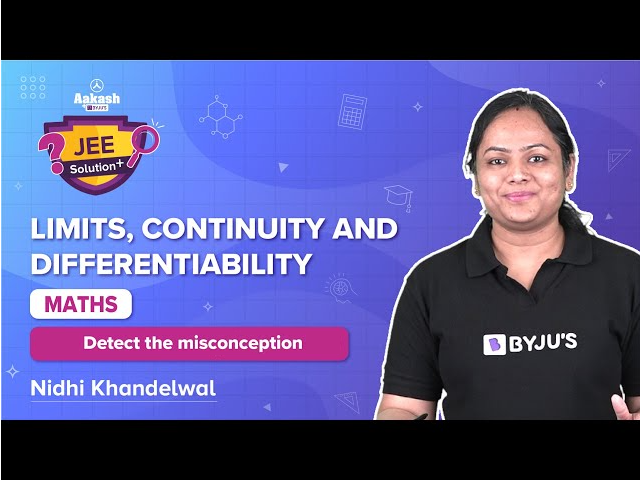In calculus, limit and continuity are important concepts. A limit is a number that a function approaches as the independent variable of the function approaches a given value. A function can either be continuous or discontinuous. Positive Discontinuity, Jump Discontinuity and Infinite Discontinuity are types of discontinuity. This article covers the questions from the definition of limit, types of limit, indeterminate form, algebra of limit, standard limits, expansion of some functions, continuity at a point, continuity in a domain, and differentiability at a point. The limits, continuity and differentiability questions from the previous years of JEE Main are present on this page, along with the detailed solution for each question. These questions include all the important topics and formulae. About 2-3 questions are asked on this topic in JEE Examination.
JEE Main Maths Limits, Continuity and Differentiability Previous Year Questions With Solutions
Question 1: Solve \(\begin{array}{l}\underset{x\to 1}{\mathop{\lim}}\,\frac{(2x-3)(\sqrt{x}-1)}{2{{x}^{2}}+x-3}\end{array} \)
Solution:
\(\begin{array}{l}\underset{x\to 1}{\mathop{\lim }}\,\,\,\frac{(2x-3)\,(\sqrt{x}-1)\times (\sqrt{x}+1)}{(x-1)\,(2x+3)\times (\sqrt{x}+1)}\\=\frac{-1}{5\,.\,2}\\=\frac{-1}{10}\end{array} \)
Question 2: If f(9) = 9, f'(9) = 4, then \(\begin{array}{l}\lim_{x \rightarrow 9}\frac{\sqrt{f(x)}-3}{\sqrt{x}-3}=\end{array} \)
Solution:
Applying L – Hospitals rule,
\(\begin{array}{l}\underset{x\to 9}{\mathop{\lim }}\,\frac{\frac{1}{2\sqrt{f(x)}}\cdot {f}'(x)}{\frac{1}{2\sqrt{x}}}\\=\frac{\frac{{f}'(9)}{\sqrt{f(9)}}}{\frac{1}{\sqrt{9}}}\\=\frac{\frac{4}{3}}{\frac{1}{3}}\\=4\end{array} \)
Question 3: Solve \(\begin{array}{l}\underset{h\to 0}{\mathop{\lim }}\,\frac{{{(a+h)}^{2}}\sin (a+h)-{{a}^{2}}\sin a}{h}\end{array} \)
Solution:
Apply the L-Hospitals rule,
\(\begin{array}{l}\underset{h\to 0}{\mathop{\lim }}\,\,\frac{{{(a+h)}^{2}}\sin (a+h)-{{a}^{2}}\sin a}{h}\end{array} \)
\(\begin{array}{l}\underset{h\to 0}{\mathop{\lim }}\,\,\,\frac{2\,(a+h)\,\sin \,(a+h)+{{(a+h)}^{2}}\cos \,(a+h)}{1}\end{array} \)
\(\begin{array}{l}=2a\,\,\sin a+{{a}^{2}}\cos \,\,a\end{array} \)
Question 4: Solve \(\begin{array}{l}\underset{x\to \pi /4}{\mathop{\lim }}\,\frac{\sqrt{2}\cos x-1}{\cot x-1}\end{array} \)
Solution:
\(\begin{array}{l}\underset{x\to \pi /4}{\mathop{\lim }}\,\frac{\sqrt{2}\cos x-1}{\cot x-1}\end{array} \)
Apply the L-Hospitals rule,
\(\begin{array}{l}=\underset{x\to \pi /4}{\mathop{\lim }}\,\frac{-\sqrt{2}\sin x}{-cosec^x}\end{array} \)
\(\begin{array}{l}\frac{-\sqrt{2}\times\frac{1}{\sqrt{2}}}{-(\sqrt{2})^2}\end{array} \)
\(\begin{array}{l}=\frac{1}{2}\end{array} \)
Question 5: Solve \(\begin{array}{l}\underset{x\to 0}{\mathop{\lim }}\,\left[ \frac{x}{{{\tan }^{-1}}2x} \right]\end{array} \)
Solution:
Let
\(\begin{array}{l}{{\tan }^{-1}}2x=\theta \\\,\Rightarrow x=\frac{1}{2}\tan \theta \ and \ as \ x\to 0,\,\,\theta \to 0 \\\Rightarrow \,\,\underset{x\to 0}{\mathop{\lim }}\,\,\frac{x}{{{\tan }^{-1}}2x}\\=\underset{\theta \to 0}{\mathop{\lim }}\,\,\frac{\frac{1}{2}\tan \theta }{\theta }\\=\frac{1}{2}.(1)\\ =\frac{1}{2}\end{array} \)
Question 6: Solve \(\begin{array}{l}\underset{x\to 0}{\mathop{\lim }}\,\frac{\sqrt{\frac{1}{2}(1-\cos 2x)}}{x}\end{array} \)
Solution:
\(\begin{array}{l}\underset{x\to 0}{\mathop{\lim }}\,\,\frac{\sqrt{\tfrac{1}{2}(1-\cos 2x)}}{x}=\underset{x\to 0}{\mathop{\lim }}\,\,\frac{|\,\,\sin x\,\,|}{x}\end{array} \)
So,
\(\begin{array}{l}\underset{x\to 0+}{\mathop{\lim }}\,\,\frac{|\,\sin x\,|}{x}=1\end{array} \)
and
\(\begin{array}{l}\underset{x\to 0-}{\mathop{\lim }}\,\,\frac{|\,\sin x\,|}{x}=-1\end{array} \)
Hence, the limit doesn’t exist.
Question 7: Solve \(\begin{array}{l}\underset{x\to 0}{\mathop{\lim }}\,{{\left\{ \tan \left( \frac{\pi }{4}+x \right) \right\}}^{1/x}}\end{array} \)
Solution:
Given,
\(\begin{array}{l}\underset{x\to 0}{\mathop{\lim }}\,{{\left\{ \tan \left( \frac{\pi }{4}+x \right) \right\}}^{1/x}}\end{array} \)
\(\begin{array}{l}=\underset{x\to 0}{\mathop{\lim }}\,\,\,{{\left( \frac{1+\tan x}{1-\tan x} \right)}^{1/x}} \end{array} \)
\(\begin{array}{l}=\displaystyle \lim_{x \to 0}\left ( 1+\left ( \frac{1+tan x}{1-tanx}-1 \right ) \right )^{\frac{1}{x}}\end{array} \)
\(\begin{array}{l}=\displaystyle \lim_{x \to 0}\left ( 1+\left ( \frac{2\ tan x}{1-tanx} \right ) \right )^{\frac{1}{x}}\end{array} \)
\(\begin{array}{l}=e^{\displaystyle \lim_{x \to 0}\left( \frac{2\ tan x}{x(1-tanx)} \right )}\end{array} \)
= e2
Question 8: Solve \(\begin{array}{l}\underset{x\to 0}{\mathop{\lim }}\,{{\left( \frac{1+5{{x}^{2}}}{1+3{{x}^{2}}} \right)}^{1/{{x}^{2}}}}\end{array} \)
Solution:
\(\begin{array}{l}\underset{x\to 0}{\mathop{\lim }}\,\,{{\left( \frac{1+5{{x}^{2}}}{1+3{{x}^{2}}} \right)}^{1/{{x}^{2}}}}\\=\frac{\underset{x\to 0}{\mathop{\lim }}\,\,\,{{\left[ {{(1+5{{x}^{2}})}^{1/5{{x}^{2}}}} \right]}^{5}}}{\underset{x\to 0}{\mathop{\lim }}\,\,\,{{\left[ {{(1+3{{x}^{2}})}^{1/3{{x}^{2}}}} \right]}^{3}}}\\=\frac{{{e}^{5}}}{{{e}^{3}}}\\={{e}^{2}}\end{array} \)
\(\begin{array}{l}[\because \,\,\,\underset{x\to 0}{\mathop{\lim }}\,\,{{(1+x)}^{1/x}}=e]\end{array} \)
Question 9: Solve \(\begin{array}{l}\underset{x\to 0}{\mathop{\lim }}\,\frac{x\tan 2x-2x\tan x}{{{(1-\cos 2x)}^{2}}}\end{array} \)
Solution:
\(\begin{array}{l}\underset{x\to 0}{\mathop{\lim }}\,\,\frac{x\tan 2x-2x\tan x}{{{(1-\cos \,\,2x)}^{2}}}\\=\underset{x\to 0}{\mathop{\lim }}\,\,\frac{x(\tan \,\,2x-2\tan x)}{{{(2\,{{\sin }^{2}}x)}^{2}}}\\=\underset{x\to 0}{\mathop{\lim }}\,\,\,\frac{1}{4}\,\frac{x\,(\tan 2x-2\tan x)}{{{\sin }^{4}}x}\end{array} \)
\(\begin{array}{l}= \lim_{x \to 0}\frac{x}{4sin^4 x}\left ( \frac{2\ tanx}{1-tan^2 x}-2\ tan x \right )\end{array} \)
\(\begin{array}{l}= \lim_{x \to 0}\frac{x}{4sin^4 x}\left ( \frac{2\ tanx-2\ tan x+2\ tan^3 x}{1-tan^2 x} \right )\end{array} \)
\(\begin{array}{l}= \lim_{x \to 0}\frac{x}{4sin^4 x}\left ( \frac{2\ tan^3 x}{1-tan^2 x} \right )\end{array} \)
\(\begin{array}{l}= \frac{1}{2}\lim_{x \to 0}\frac{x}{sinx}.\frac{tan^3 x}{sin^3 x}.\frac{1}{1-tan^2 x}\end{array} \)
\(\begin{array}{l}= \frac{1}{2}\lim_{x \to 0}\frac{1}{\frac{sinx}{x}}.\frac{1}{cos^3 x}.\frac{1}{1-tan^2 x} \end{array} \)
\(\begin{array}{l}=\frac{1}{2}\times 1\times \frac{1}{1}\times \frac{1}{1}\end{array} \)
\(\begin{array}{l}=\frac{1}{2}\end{array} \)
Question 10: The function \(\begin{array}{l}f(x)=\frac{\log (1+ax)-\log (1-bx)}{x}\end{array} \)
is not defined at x = 0. The value which should be assigned to f at x = 0 so that it is continuous at x = 0, is
Solution:
Since the limit of a function is a + b as x → 0, therefore to be continuous at a function, its value must be a + b at x = 0
⇒ f (0) = a + b
Question 11: Evaluate \(\begin{array}{l}f(x)=\begin{cases}\frac{{{x}^{3}}+{{x}^{2}}-16x+20}{{{(x-2)}^{2}}} & \text{ if } x\ne2 \\k & \text{ if } x= 2\end{cases}\end{array} \)
Solution:
For continuous
\(\begin{array}{l}\underset{x\to 2}{\mathop{\lim }}\,\,f(x)=f(2)=k \\\Rightarrow \,\,k=\underset{x\to 2}{\mathop{\lim }}\,\frac{{{x}^{3}}+{{x}^{2}}-16x+20}{{{(x-2)}^{2}}} \\=\underset{x\to 2}{\mathop{\lim }}\,\,\frac{({{x}^{2}}-4x+4)\,\,(x+5)}{{{(x-2)}^{2}}}\\=\underset{x\to 2}{\mathop{\lim }}\,\,\frac{(x-2)^2\,\,(x+5)}{{{(x-2)}^{2}}}\\=7 .\end{array} \)
Question 12: If \(\begin{array}{l}f(x)=\begin{cases}\frac{{{x}^{2}}-4x+3}{{{x}^{2}}-1} & \text{ if } x\ne1 \\2 & \text{ if } x= 1\end{cases}\end{array} \)
, then find the condition for the function to be continuous or discontinuous.
Solution:
\(\begin{array}{l}f(x)=\left\{ \frac{{{x}^{2}}-4x+3}{{{x}^{2}}-1} \right\}\end{array} \)
for x = 1
f (1) = 2,
\(\begin{array}{l}f(1+)=\underset{x\to 1+}{\mathop{\lim }}\,\,\frac{{{x}^{2}}-4x+3}{{{x}^{2}}-1}\\=\underset{x\to 1+}{\mathop{\lim }}\,\,\frac{(x-3)}{(x+1)}\\=-1 \\f(1-)=\underset{x\to 1-}{\mathop{\lim }}\,\,\frac{{{x}^{2}}-4x+3}{{{x}^{2}}-1}\\=-1\,\,\\\Rightarrow \,\,f(1)\ne f(1-)\end{array} \)
Hence, the function is discontinuous at x = 1.
Question 13: Which of the following functions have a finite number of points of discontinuity in R ([.] represents the greatest integer function)?
(A) tan x
(B) x[x]
(C) |x| / x
(D) sin[πx]
Solution:
f (x) = tanx is discontinuous when x = (2n + 1) π / 2, n ∈ Z
f (x) = x[x] is discontinuous when x = k, k ∈ Z
f (x) = sin [nπx] is discontinuous when nπx = k, k ∈ Z
Thus, all the above functions have an infinite number of points of discontinuity. But, if (x) = |x| / x is discontinuous when x = 0 only.
Question 14: The number of values of x ∈ [0, 2] at which f (x) = |x − (1/2)| + |x − 1|+ tan x is not differentiable is
(A) 0
(B) 1
(C) 3
(D) None of these
Solution:
|x − (1/2)| is continuous everywhere but not differentiable at x = 1 / 2, |x − 1| is continuous everywhere, but not differentiable at x = 1 and tan x is continuous in [0, 2] except at x = π/2.
Hence, f (x) is not differentiable at x = 1/2, 1, π/2.
Answer: (C) 3
Question 15:
\(\begin{array}{l}\underset{x\to \pi /2}{\mathop{\lim }}\,(\sec \theta -\tan \theta )=\end{array} \)
Solution:
\(\begin{array}{l}\underset{\theta \to \pi /2}{\mathop{\lim }}\,\,\,\frac{1-\sin \theta }{\cos \theta }=\underset{\theta \to \pi /2}{\mathop{\lim }}\,\,\,\frac{{{\left( \cos \frac{\theta }{2}-\sin \frac{\theta }{2} \right)}^{2}}}{\left( \cos \frac{\theta }{2}-\sin \frac{\theta }{2} \right)\,\left( \cos \frac{\theta }{2}+\sin \frac{\theta }{2} \right)}=0\end{array} \)
Also, Read
JEE Advanced Maths Limits Previous Year Questions with Solutions
Video Lesson:
Limits, Continuity and Differentiability – Part 1
Limits, Continuity and Differentiability – Part 2
Limits, Continuity and Differentiability – Important Topics
Limits, Continuity and Differentiability – Important Questions




Comments